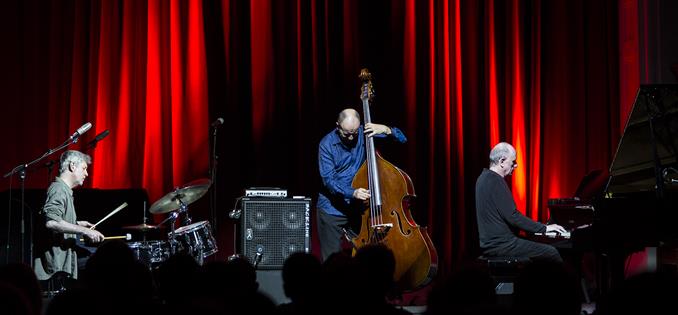*****
Their music is virtuosic, but completely devoid of ego
On a rainy night in Manchester, while the America people are voting for what may turn out to be the final time, three fifty-something men in grey shirts take to the stage of Band on the Wall and begin to check their instruments. The venue is packed. This is already impressive for a Tuesday, but all the more so when you consider that the group people are paying £18 to see are a free-improvising trio from Australia, known for their hour-long sets of minimalist ambient jazz. The Necks consist of Chris Abrahams (piano), Tony Buck (drums) and Lloyd Swanton (bass). Formed in Sydney in 1987, they have been continuously active for almost thirty years, in which time they’ve toured the world repeatedly and recorded eighteen live and studio albums, as well as the soundtrack of an Australian crime drama. At this point, everyone in the audience knows what to expect. But that doesn’t diminish the impact.
The first set is all about space and atmosphere. Beginning with a looping piano arpeggio that meanders up and down the white notes of the keyboard, it slowly expands with the entry of the other musicians into a journey through a wide-open landscape. The bowed bass pulses in Reichian ebbs and flows, while the drums sound less like a musical instrument than a battery of meteorological effects. Buck taps and brushes the kit to produce everything from rolling fog to the chirping of cicadas and the rumble of distant thunder. A sudden shift (or as close to a sudden shift as you can get at a Necks gig) occurs when Swanton moves to pizzicato, introducing a crepuscular groove that runs and runs with tiny variations – a central rhythm around which the drums and piano circle and chafe. After forty minutes or so, the piece reaches a surprisingly dramatic climax and comes to an end. The audience react with passionate applause. Swanton grabs the mic and introduces the members of the group; it’s the first time any of them has said a word.
 The Necks
The NecksAfter a short break, the second set begins in a style that can only be described as almost like jazz. Abrahams plays melodic flurries on the keyboard while Buck accompanies with a classic ride-cymbal pattern. Somewhere in the midst of it all you can almost make out a chord progression. But the playful mood soon gives way to something more insistent, as Swanton’s bass playing again takes on a central role. After a while the acoustic instrumentation begins to sound uncannily electronic – the obsessive hammering of the piano’s upper register resembling something out of an IDM album. Or maybe it’s more like krautrock. Building to a motorik throb, which sees Swanton frantically strumming a single chord on his bass, the piece peaks and drops back into a gentler rhythm, ending abruptly when Abrahamson just stops playing. For probably the first time ever, there’s a sense that a set has gone on exactly just a bit too long enough. On top of the applause, there are many loud, enthusiastic woops.
It’s difficult to know what to say about the Necks. You can watch them play for almost two hours and immediately afterwards you’ll struggle to recognise them in the bar. Their music is virtuosic, but completely devoid of ego; in its rejection of the role of the soloist it can be seen as a kind of anti-jazz. But what’s most remarkable is the sheer scope and richness of the musical world that these three men are able to conjure with their conventional piano-trio instrumentation. Their many albums range from avant-rock to raga to (yes) jazz while always remaining immediately recognisable. In the end, it turns out they’re just The Necks – three guys from Sydney who may not quite be able to make time stand still, but certainly know how to make it run.
The Necks’ European tour continues for the rest of November.
Image credits: Holimage and Alun Murphy
 Powered by Wakelet
Powered by Wakelet














